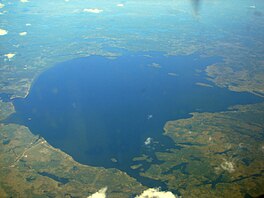
The Canadian Shield, also called the Laurentian Shield or the Laurentian Plateau, is a geologic shield, a large area of exposed Precambrian igneous and high-grade metamorphic rocks. It forms the North American Craton, the ancient geologic core of the North American continent. Glaciation has left the area with only a thin layer of soil, through which exposures of igneous bedrock resulting from its long volcanic history are frequently visible. As a deep, common, joined bedrock region in eastern and central Canada, the shield stretches north from the Great Lakes to the Arctic Ocean, covering over half of Canada and most of Greenland; it also extends south into the northern reaches of the United States.

An impact crater is a circular depression in the surface of a solid astronomical object formed by the hypervelocity impact of a smaller object. In contrast to volcanic craters, which result from explosion or internal collapse, impact craters typically have raised rims and floors that are lower in elevation than the surrounding terrain. Impact craters range in size from microscopic craters seen on lunar rocks returned by the Apollo Program to simple bowl-shaped depressions and vast, complex, multi-ringed impact basins. Meteor Crater is a well-known example of a small impact crater on Earth.

Sudbury, officially the City of Greater Sudbury, is the largest city in Northern Ontario by population, with a population of 166,004 at the 2021 Canadian Census. By land area, it is the largest in Ontario and the fifth largest in Canada. It is administratively a single-tier municipality and thus is not part of any district, county, or regional municipality. The City of Greater Sudbury is separate from, but entirely surrounded by the Sudbury District. The city is also referred to as "Ville du Grand Sudbury" among Francophones.

Manicouagan Reservoir is an annular lake in central Quebec, Canada, covering an area of 1,942 km2 (750 sq mi). The lake island in its centre is known as René-Levasseur Island, and its highest point is Mount Babel. The structure was created 214 (±1) million years ago, in the Late Triassic, by the impact of a meteorite 5 km (3 mi) in diameter. The lake and island are clearly seen from space and are sometimes called the "eye of Quebec". The lake has a volume of 137.9 km3 (33.1 cu mi).

The French River is a river in Central Ontario, Canada. It flows 110 kilometres (68 mi) from Lake Nipissing southwest to Georgian Bay. The river largely follows the boundary between the Parry Sound District and the Sudbury District, and in most contexts is considered the dividing line between Northern and Southern Ontario. The French River was designated a Canadian Heritage River in 1986.

Nickel Centre was a town in Ontario, Canada, which existed from 1973 to 2000.
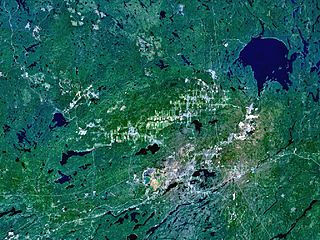
The Sudbury Basin, also known as Sudbury Structure or the Sudbury Nickel Irruptive, is a major geological structure in Ontario, Canada. It is the third-largest known impact crater or astrobleme on Earth, as well as one of the oldest. The crater was formed 1.849 billion years ago in the Paleoproterozoic era.
The Brent crater is an impact crater in both the geographic township of Deacon, Unorganized South Nipissing District and the municipal township of Papineau-Cameron in Nipissing District, northeastern Ontario, Canada, located north of Cedar Lake in northern Algonquin Provincial Park. It is 3.8 kilometres (2.4 mi) in diameter and the age is estimated to be ca. 453 million years (Ordovician). The crater can be reached using Brent Road, 32 kilometres (20 mi) south of Ontario Highway 17.

Lappajärvi is a lake in Finland, in the municipalities of Lappajärvi, Alajärvi and Vimpeli. It is formed in a 23 km (14 mi) wide, partly eroded meteorite impact crater. The lake is part of Ähtävänjoki basin together with Lake Evijärvi that is located downstream (north) of it.
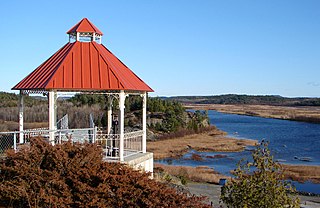
The Spanish River is a river in Algoma District, Sudbury District and Greater Sudbury in Northeastern Ontario, Canada. It flows 338 kilometres (210 mi) in a southerly direction from its headwaters at Spanish Lake and Duke Lake to its mouth at the North Channel of Lake Huron just outside the community of Spanish.
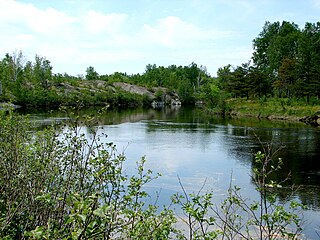
The Wanapitei River is a river in Northeastern Ontario, Canada. It is in the Great Lakes Basin and is a right tributary of the French River.

Greater Sudbury City Council is the governing body of the City of Greater Sudbury, Ontario, Canada.

The Slate Islands are a small archipelago in Lake Superior, Ontario, Canada, about 12 kilometres (7.5 mi) south of the town of Terrace Bay. The island group, consisting of 15 islands in total, was created by a meteorite impact which formed a crater about 32 km (20 mi) wide. In 1985, the Ontario government established the Slate Islands as a natural environment provincial park. The islands are notable for having Ontario's largest herd of boreal woodland caribou.

Ramsey Lake is a lake in Sudbury, Ontario, located near the city's downtown core. Until 2001, Ramsey Lake was listed by the Guinness Book of World Records as the world's largest lake located entirely within the boundaries of a single city, but when the Regional Municipality of Sudbury was amalgamated into the current city of Greater Sudbury, Ramsey Lake lost this status to the larger Lake Wanapitei, approximately 20 kilometres (12 mi) to the northeast.
The Wahnapitae First Nation is an Ojibway First Nation band government in the Canadian province of Ontario, who primarily reside on the 1,036-hectare (2,560-acre) Wahnapitae Indian Reserve No. 11 on the northwestern shore of Lake Wanapitei. The First Nation is a signatory to the Robinson-Huron Treaty of 1850 as the Tahgaiwenene's Band. The reserve had a resident population of 102 in the Canada 2011 Census; the First Nation also has approximately 200 further registered members who currently live off-reserve.

Secondary Highway 537, commonly referred to as Highway 537, is a provincially maintained secondary highway in the Canadian province of Ontario. The highway is 16.1 kilometres (10.0 mi) in length, connecting Highway 69 near Wanup with Finni Road. It once continued 3.6 km (2.2 mi) further to intersect Highway 17 in Wahnapitae, but was truncated in 1998; this portion of the route is now designated as Greater Sudbury Municipal Road 537. Highway 537 is now the only secondary highway in the province located within a jurisdiction that also maintains its own county/regional road network.

The Temagami Magnetic Anomaly, also called the Temagami Anomaly or the Wanapitei Anomaly, is a magnetic anomaly resulting from a large buried geologic structure in the Canadian Shield near Temagami, Ontario, Canada. It stretches from Lake Wanapitei in the west to Bear Island in Lake Temagami.

Suevite is a rock consisting partly of melted material, typically forming a breccia containing glass and crystal or lithic fragments, formed during an impact event. It forms part of a group of rock types and structures that are known as impactites.
Fairbank Lake is a lake in Northern Ontario, Canada, located within the Walden region of Greater Sudbury.
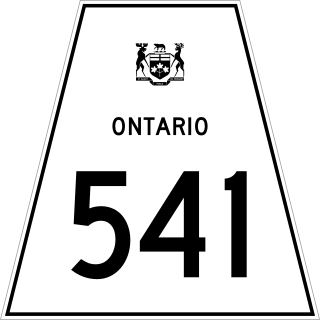
Secondary Highway 541, commonly referred to as Highway 541, was a provincially maintained secondary highway in the Canadian province of Ontario. The highway connected Highway 17 in Sudbury with the community of Skead on the southern shores of Lake Wanapitei, passing through the community of Garson en route. Within the urban region of Sudbury, the highway served to access Sudbury Airport. The designation was applied in 1956, along with many of the secondary highways in Ontario. The province transferred responsibility for the route shortly after the creation of the Regional Municipality of Sudbury in 1973. Highway 541 is now known as Sudbury Municipal Road 86, following Falconbridge Highway and Skead Road.
